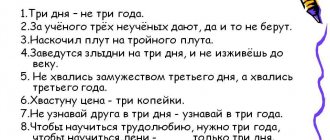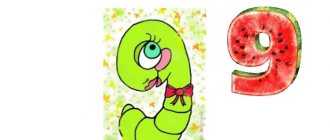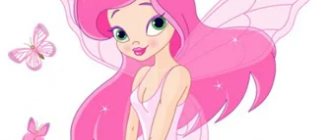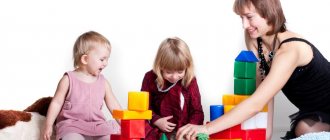Step-by-step instructions for teaching your child to count
Adults think and perceive the world differently: some are better at working with images and objects, while others find it easier to navigate abstract mathematical categories. As for small children, everything is simpler: all of them, with rare exceptions, perceive the world through objects, and abstractions for the time being are beyond their understanding.
Therefore, in order to teach a child to count, it is necessary to operate either with the objects themselves or with their images. The first is preferable, since it is very important that the baby can not only see what he has to count, but also touch, smell and even, possibly, taste.
The reason lies precisely in the fact that he needs to link an abstract number with an object that is understandable to him, real and perceptible by all senses. These can be fruits, vegetables, candies, toys, and even your own fingers (in this case, of course, you shouldn’t try them on your teeth).
It is especially important to work with objects when you are dealing with very young children aged 1.5-2 years. Older guys are already excellent at using pictures.
"Dog and Cat"
You can start learning at about one and a half years old, but at this age, when the child still does not really know how to speak, you should not expect any outstanding results from him. Just introduce him to the concept of counting - lay out toys in front of him and say: “Here is one dog. But here is a dog and a cat” and so on. Give your baby a toy in each hand so that he subconsciously associates their number with the number of hands. In a word, prepare him for future training.
Count everything you see
From the age of three you can begin full-time education. And start with the simplest thing, with your fingers, because there are ten of them. From this age on, try to talk to your child about numbers as much as possible. These can be the simplest phrases: “We live on the third floor,” “We need bus number 15, and we get off at the fourth stop,” and so on. Ask your child to count all the objects he sees, as well as steps, steps and any actions he performs. At this stage of learning, it is already quite possible to work with pictures, so you can make special cards that will depict a different number of objects known to the baby: one apple, two plums, three berries. All kinds of counting poems are very useful at this stage - they are easy to remember, and counting is learned along with them.
In general, when starting to teach your child to count, remember two important things.
- Until about 5 years of age, a child cannot operate with abstract concepts, so counting must be tied to specific objects - real or drawn. For the same reason, do not try to immediately show your child writing numbers, at least until he begins to confidently count to 10 and solve simple addition and subtraction problems.
- Never scold your child for mistakes, but do not skimp on praise. Studying should evoke only positive emotions in him, and the approval of his parents gives him an incentive to study better.
How to teach a child numbers?
The sooner the learning process begins (especially in a home atmosphere), the easier it will be to achieve a positive result. The main thing is that it is interesting, entertaining and unobtrusive. It is not difficult to learn, since memorizing the number easily occurs during the game, using colorful pictures, vivid visual images, and favorite toys.
Learning numbers with preschoolers for younger and middle ages
Learning numbers with preschoolers for younger and middle ages
Goal: fix the score within 5.
Tasks: Familiarize yourself with numbers from 0 to 5.
Develop a sense of love for nature.
I would like to present my work (Video “Learning numbers”, where I tried to attract children’s attention to objects of living and inanimate nature. Children can easily watch a ladybug in a playful way. Which symbolizes an object of living nature (bees, frogs, turtles).
Mathematics for children. Where to start studying numbers
From the age of two, children's thinking develops at a rapid pace. Now is the time to introduce your child to simple math concepts and counting. Kids already know many geometric shapes and have an idea of shape and size. Educational games and exercises will help you become familiar with numbers and numbers.
If you study regularly, then by the age of three you will be able to develop the first mathematical skills:
- the baby will learn to count consistently from one to five;
- will understand the difference between the concepts “one” and “many”;
- will learn what the words “more, less, equally” mean, will get used to comparing groups of objects;
- remember the graphic image of the first five numbers, be able to recognize them on cards and compare them with the quantity;
- recognizes the signs “+” and “―”, learns to perform simple examples of addition and subtraction.
At first, the baby learns to count objects by pointing at them or touching them with a finger. This makes it easier to engage in visual-figurative thinking. To make counting a habitual activity, ask your baby to help you. Let him bring a certain number of spoons, apples, socks.
An indispensable condition for success is a good mood of the child and mother, praise for the efforts of the baby. When you notice signs of fatigue, take a break: let the baby jump, run, and rest. A quarter of an hour a day is enough for casual activities.
Summary of mathematics lessons for preschoolers. Number and figure 5
Summary of a math lesson for preschoolers “Number and figure 5”
Summary of a lesson in kindergarten using a notebook by Peterson L.G.
HER. Kochemasova “Player” Author: Rubtsova Natalya Mikhailovna Place of work, position Teacher MBOU Secondary School No. 55, Nizhny Novgorod Purpose: familiarity with the number and the number 5, the ability to correlate number with quantity. Progress of the lesson Work with task No. 1. Educator:
Guys, what holiday do you love most?
Children's answers. Educator:
Do you like the New Year?
Children:
yes.
Educator:
What do we dress up for the New Year?
Children:
Christmas tree.
Educator:
What do we decorate it with?
Children:
beads, balls, flags.
Educator:
Pinocchio decided to make a garland and cut out flags from white paper.
But Malvina is not very happy, because the flags should be bright, festive, joyful. Let's help Pinocchio color the flags. A garland with 5 flags should be blue, a garland with 3 flags should be red. A garland with 4 flags must be painted yellow. Color the remaining garland so that all the flags are different colors. Children complete the task. Working with task No. 2. Educator:
Guys, for the New Year a Christmas tree is installed not only at home.
Where else have you seen the New Year's beauty? Children:
in stores, on the street.
Educator:
Why do you think Christmas trees are decorated on the streets?
Children:
to make it beautiful and festive.
Educator:
Look, there are two houses in the picture.
In the house that is located to the right of the tree, paint the roof red, and to the left of the tree – yellow. Children complete the task. Educator:
What is the difference between windows in houses?
Children:
form.
Educator:
light up as many windows of the same shape in the house as the number below shows.
Count the square (triangular) windows in a house with a yellow roof. Children count windows Educator:
Is it possible to color square (triangular) windows?
Children:
It’s impossible, because there are 3 of them, but you need to color 4 identical windows.
Educator:
Count the round windows.
Children count. Educator:
Is it possible to color them?
Children:
yes, there are 4 of them.
Educator:
Count the windows in the house with a red roof.
What shape of windows will we paint? Children:
square.
Working with task No. 3 . Educator:
there is a garland in the picture, but not all the light bulbs in it work.
Paint the light bulbs with the desired color. Children complete the task. Physical education minute Pinocchio stretched, bent over once, bent over twice, spread his arms to the sides, apparently couldn’t find the key. To get the key, we need to stand on our toes. Working with task No. 4. Educator:
the day after the New Year, Malvina washed the dishes and began to put them on the shelves.
Let's help Malvina? Leave as many items on each shelf as the number shows, cross out the remaining items. Children complete the task. Working with task No. 5. Educator:
Look at the picture.
What do you think Buratino is doing? Children:
he puts away the toys.
Educator:
Let's help her.
What's on every shelf? Children:
ball, pyramid, cube.
Educator:
Which shelf is missing a toy?
Children:
on the bottom.
Educator:
What toy is missing on the bottom shelf?
Children:
pyramids.
Educator:
What color should the pyramid be placed on the shelf?
Children:
red.
Working with task No. 6. Educator:
Guys, what is this scattered here?
Children:
numbers.
Educator:
What are the numbers here?
Children:
1, 2,3, 4, 5.
Educator:
Circle numbers 5 in a red circle, cross out numbers 4, and connect numbers 3 with a line.
Children complete the task. Educator:
Thank you for your work!
We recommend watching:
Summary of GCD in the middle group on FEMP on the topic “Fun Mathematics” Scenario of a mathematical holiday for kindergarten Consultation for parents of kindergarten Consultation for parents of kindergarten. Development of mathematical abilities in preschoolers
Similar articles:
How to teach a child to count
Development of mathematical concepts of children of primary preschool age in the design process
GCD summary. Formation of elementary mathematical concepts in preschoolers
Mathematical KVN in the senior, preparatory group
Mathematical riddles for preschoolers in verse
At what age can you start teaching children to count?
Natalya Melnichuk, director, educational psychologist of children's development programs (Simferopol):
— We teach counting to children from the age of two. We study counting by playing various games using counting material. The counting material can be anything: capsules from Kinder surprises, various wooden or plastic figures, balls. Active musical games aimed at collecting the required number of objects work very well.
In fact, even a one-year-old toddler can remember numbers. It is enough to regularly show him a visual designation of a number throughout the day and say its name out loud. When the baby begins to speak, he will be able to reproduce the words heard in the cradle and associate them with the image of a specific sign.
At the age of 3-5 years, play becomes the main form of activity. She helps the baby learn numbers and count, find out the number and determine the number of objects.




